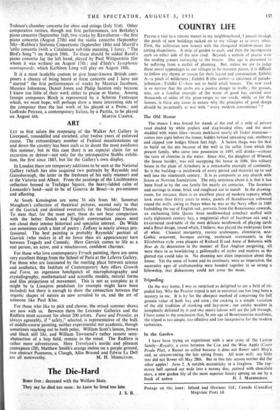ART
Ler us first salute the reopening of the Walker Art Gallery in Liverpool, remodelled and enriched, after twelve years of enforced recess. The extraordinary number of Festival manifestations up and down the country has been such as to daunt the most assiduous this summer, but in this case there is an especial claim for an excursion or detour—not only for the retrospective Stubbs exhibi- tion, the first since 1885, but for the Gallery's own display.
In London there are temporary additions to be seen at the National Gallery (which has also acquired two portraits by Reynolds and Gainsborough, the latter in the freshness of his early manner) and at the Victoria and Albert. From the paintings of the Liechtenstein collection housed in Trafalgar Square, the heavy-lidded calm- of Leonardo's head—said to be of Ginevra de Benci=is pre-eminent and affecting.
At South Kensington are some 36 oils from Mr. Somerset Maugham's collection of theatrical pictures, second only to that of the Garrick and destined eventually for the National Theatre. To state that, for the most part, these do not bear comparison with the better Dutch and English conversation pieces need not cloud their intense historical and specialist interest. De Wilde can sometimes catch a hint of poetry ; Zoffany is nearly always pro- fessional. The _best painting is probably Reynolds' portrait of Garrick (who makes in all no fewer than six appearances) torn between Tragedy and Comedy. Here Garrick comes to life as a real person, an actor, and a mischievous, confident charmer.
For those who love contemporary French painting, there are some very excellent things from the School of Paris at the Lefevre Gallery. For those who are fascinated by the meeting place between science and aesthetics, the Institute of Contemporary Arts offers Growth and Form, an ingenious hotchpotch of microphotography and crystallography, mathematical and scientific models, natural forms and film projections of movement. This is not as complete as it might be (a Lissajous pendulum for example might have been included) but there is enough to show the connection between the- organic shapes of nature as now revealed to us, and the art of someone like Paul Klee.
For those who like to pick and choose, the mixed summer shows are now with us. Between them the Leicester Galleries and the Redfern must account for abotit 200 artists. Fame and Promise, as always agreeably, if " safely," selected, is representative of the bulk of middle-course painting, neither experimental nor academic, though sometimes reaching out to both poles, William Scott's lemon, brown and black still life, and William Townsend's rather remote semi- abstraction of a hop field, remain in the mind. The Redfern is rather more adventurous. Here Trevelyan's nordic and pleasant centrepiece (20), Matthew Smith's orange melon on a purple ground, two abstract Pasmores, a Clough, Allin Braund and Edwin La Dell






























 Previous page
Previous page